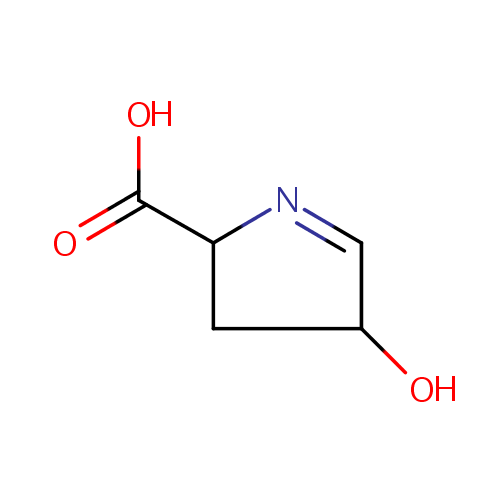|
Record Information |
|---|
| Version |
1.0 |
|---|
| Update Date |
1/22/2018 11:54:54 AM |
|---|
|
Metabolite ID | PAMDB000359 |
|---|
|
Identification |
|---|
| Name: |
Pyrroline hydroxycarboxylic acid |
|---|
| Description: | Pyrroline hydroxycarboxylic acid is an intermediate in arginine and proline metabolism. It is converted to trans-4-hydroxy-L-proline via pyrroline-5-carboxylate reductase, and to L-erythro-4-Hydroxyglutamate via delta-1-pyrroline-5-carboxylate dehydrogenase. (KEGG) |
|---|
|
Structure |
|
|---|
| Synonyms: | - (3R,5S)-1-pyrroline-3-hydroxy-5-carboxylate
- (3R,5S)-1-Pyrroline-3-hydroxy-5-carboxylic acid
- 3-Hydroxy-L-1-pyrroline-5-carboxylate
- 3-Hydroxy-L-1-pyrroline-5-carboxylic acid
- L-Δ1-pyrroline 3-hydroxy-5-carboxylate
- L-Δ1-pyrroline 3-hydroxy-5-carboxylic acid
- L-Δ1-pyrroline 3-hydroxy-5-carboxylate
- L-1-Pyrroline 3-hydroxy-5-carboxylate
- L-1-Pyrroline 3-hydroxy-5-carboxylic acid
- L-1-Pyrroline-3-hydroxy-5-carboxylate
- L-1-Pyrroline-3-hydroxy-5-carboxylic acid
- L-1pyrroline-3-hydroxy-5-carboxylate
- L-1Pyrroline-3-hydroxy-5-carboxylic acid
- L-Delta1-pyrroline 3-hydroxy-5-carboxylate
- L-Delta1-pyrroline 3-hydroxy-5-carboxylic acid
- L-δ1-Pyrroline 3-hydroxy-5-carboxylate
- L-δ1-Pyrroline 3-hydroxy-5-carboxylic acid
- Pyrroline hydroxycarboxylate
- Pyrroline-hydroxy-carboxylate
- Pyrroline-hydroxy-carboxylic acid
|
|---|
|
Chemical Formula: |
C5H7NO3 |
|---|
| Average Molecular Weight: |
129.114 |
|---|
| Monoisotopic Molecular
Weight: |
129.042593095 |
|---|
| InChI Key: |
WFOFKRKDDKGRIK-UHFFFAOYSA-N |
|---|
| InChI: | InChI=1S/C5H7NO3/c7-3-1-4(5(8)9)6-2-3/h2-4,7H,1H2,(H,8,9) |
|---|
| CAS
number: |
22573-88-2 |
|---|
| IUPAC Name: | 4-hydroxy-3,4-dihydro-2H-pyrrole-2-carboxylic acid |
|---|
|
Traditional IUPAC Name: |
pyrroline-hydroxy-carboxylate |
|---|
| SMILES: | OC1CC(N=C1)C(O)=O |
|---|
|
Chemical Taxonomy |
|---|
|
Taxonomy Description | This compound belongs to the class of organic compounds known as alpha amino acids and derivatives. These are amino acids in which the amino group is attached to the carbon atom immediately adjacent to the carboxylate group (alpha carbon), or a derivative thereof. |
|---|
|
Kingdom |
Organic compounds |
|---|
| Super Class | Organic acids and derivatives |
|---|
|
Class |
Carboxylic acids and derivatives |
|---|
| Sub Class | Amino acids, peptides, and analogues |
|---|
|
Direct Parent |
Alpha amino acids and derivatives |
|---|
| Alternative Parents |
|
|---|
| Substituents |
- Alpha-amino acid or derivatives
- Pyrroline carboxylic acid or derivatives
- Pyrroline carboxylic acid
- Pyrroline
- Secondary alcohol
- Azacycle
- Organoheterocyclic compound
- Organic 1,3-dipolar compound
- Propargyl-type 1,3-dipolar organic compound
- Monocarboxylic acid or derivatives
- Carboxylic acid
- Hydrocarbon derivative
- Organooxygen compound
- Organonitrogen compound
- Imine
- Carbonyl group
- Alcohol
- Aliphatic heteromonocyclic compound
|
|---|
| Molecular Framework |
Aliphatic heteromonocyclic compounds |
|---|
| External Descriptors |
Not Available |
|---|
|
Physical Properties |
|---|
| State: |
Solid |
|---|
| Charge: | -1 |
|---|
|
Melting point: |
Not Available |
|---|
| Experimental Properties: |
|
|---|
| Predicted Properties |
|
|---|
|
Biological Properties |
|---|
| Cellular Locations: |
Cytoplasm |
|---|
| Reactions: | |
|---|
|
Pathways: |
- Arginine and proline metabolism pae00330
|
|---|
|
Spectra |
|---|
| Spectra: |
|
|---|
|
References |
|---|
| References: |
- Kanehisa, M., Goto, S., Sato, Y., Furumichi, M., Tanabe, M. (2012). "KEGG for integration and interpretation of large-scale molecular data sets." Nucleic Acids Res 40:D109-D114. Pubmed: 22080510
- Onenli-Mungan N, Yuksel B, Elkay M, Topaloglu AK, Baykal T, Ozer G: Type II hyperprolinemia: a case report. Turk J Pediatr. 2004 Apr-Jun;46(2):167-9. Pubmed: 15214748
- Simila S: Hydroxyproline metabolism in type II hyperprolinaemia. Ann Clin Biochem. 1979 Jul;16(4):177-81. Pubmed: 533224
- Valle D, Goodman SI, Harris SC, Phang JM: Genetic evidence for a common enzyme catalyzing the second step in the degradation of proline and hydroxyproline. J Clin Invest. 1979 Nov;64(5):1365-70. Pubmed: 500817
|
|---|
| Synthesis Reference: |
Not Available |
|---|
| Material Safety Data Sheet (MSDS) |
Not Available |
|---|
|
Links |
|---|
| External Links: |
|
|---|


